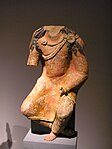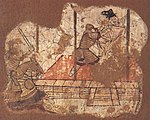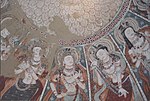 Kumtula Grottoes | |
| Location | Xinjiang, China |
|---|---|
| Coordinates | 41°42′42″N 82°40′42″E / 41.7117°N 82.6784°E |
The Kumtura Thousand Buddha Caves ( simplified Chinese: 库 木 吐 喇 千 佛 洞; traditional Chinese: 庫木吐喇千佛洞; pinyin: Kùmùtǔlǎ Qiānfódòng) (also Qumtura) is a Buddhist cave temple site in the Autonomous Region of Xinjiang, China. The site is located some 25 km west of Kucha, Kuqa County, on the ancient Silk Road. [1] [2] Other famous sites nearby are the Kizilgaha caves, the Kizil Caves, Subashi Temple and the Simsim caves. [3]
112 cave temples survive, dating from the fifth to the eleventh centuries. Damaged by occasional habitation after abandonment of the site, Kumtura was visited by a number of the early foreign expeditions to Chinese Central Asia, including the 1902 Ōtani expedition, Oldenburg, and Le Coq. [4] [5] [6] [7] The last detached several wall paintings and took them back to Berlin (now at the Museum für Asiatische Kunst). [8]
Construction of the Dongfang Hong Hydroelectric Plant in the 1970s caused the water level of the Muzat River to rise and has increased the rate of decay of the wall paintings. [1] Long-term preservation measures under the auspices of UNESCO began in 1999 with extensive documentation and survey work and consolidation of the conglomerate rock from which the caves are excavated. [1] [9] The site was among the first to be designated for protection in 1961 as a Major National Historical and Cultural Site. [10] In 2008 Kumtula Grottoes was submitted for future inscription on the UNESCO World Heritage List as part of the Chinese Section of the Silk Road. [11]
Gallery
-
Kumtura Caves overview
-
The Kumtura Grottoes are located along the Muzat River.
-
Kumtura Caves, sample plan
-
Headless statue from Kumtura at the Museum für Asiatische Kunst, Berlin
-
Donors in Hephthalite style, Kumtura Caves. Similar donors can be seen in the Kizil Caves. [12] [13] Circa 500 CE. [14] [15]
-
Group of donors in Tocharian clothing, Kumtura Caves.
-
Dignitary seized by soldiers. Kumtura painting, 8th-9th century CE
-
Statuettes of Devatas, Kumtura
-
Man in royal attire, Kumtura Caves
-
Kumtura deity (dome)
-
Kumtura deity (dome)
-
Fresco on the dome
See also
- Principles for the Conservation of Heritage Sites in China
- National Heritage Sites in Xinjiang
- Ah-ai Grotto
- Kizil Caves
- Bezeklik Thousand Buddha Caves
- Mogao Caves
- International Dunhuang Project
References
- ^ a b c Agnew, Neville, ed. (2010). Conservation of Ancient Sites on the Silk Road: Proceedings of the Second International Conference (PDF). Getty Conservation Institute. pp. 37–9. ISBN 9781606060131.
- ^ Wang Weidong, ed. (2008). 库木吐喇石窟内容总录 [A general record of the Kumtura caves] (in Chinese). 文物出版社. ISBN 9787501023844.
- ^ (Other than Kizil)... "The nearby site of Kumtura contains over a hundred caves, forty of which contain painted murals or inscriptions. Other cave sites near Kucha include Subashi, Kizilgaha, and Simsim." in Buswell, Robert E.; Lopez, Donald S. (24 November 2013). The Princeton Dictionary of Buddhism. Princeton University Press. p. 438. ISBN 978-1-4008-4805-8.
- ^ "Japanese Collections". International Dunhuang Project. Retrieved 28 April 2012.
- ^ "Russian Collections". International Dunhuang Project. Retrieved 28 April 2012.
- ^ "German Collections". International Dunhuang Project. Retrieved 28 April 2012.
- ^ Hopkirk, Peter (1984). Foreign Devils on the Silk Road: The Search for the Lost Cities and Treasures of Chinese Central Asia. University of Massachusetts Press. ISBN 0870234358.
- ^ "MIA Kumtura Collection". University of Washington. Retrieved 28 April 2012.
- ^ "The Conservation and Restoration of Kumtura Thousand Buddha Caves". UNESCO. Archived from the original on 18 January 2013. Retrieved 28 April 2012.
- ^ "国务院关于公布第一批全国重点文物保护单位名单的通知 (1st Designations)" (in Chinese). State Administration of Cultural Heritage. 3 April 1961. Archived from the original on 9 June 2012. Retrieved 28 April 2012.
- ^ "Chinese Section of the Silk Road". UNESCO. Retrieved 28 April 2012.
- ^ Kageyama, Etsuko (2016). "Change of suspension systems of daggers and swords in eastern Eurasia: Its relation to the Hephthalite occupation of Central Asia" (PDF). ZINBUN. 46: 200-202.
- ^ Kurbanov, Aydogdy (2014). "THE HEPHTHALITES: ICONOGRAPHICAL MATERIALS" (PDF). Tyragetia. 8: 324.
- ^ MUZIO, CIRO LO (2008). "Remarks on the Paintings from the Buddhist Monastery of Fayaz Tepe (Southern Uzbekistan)". Bulletin of the Asia Institute. 22: 202, note 45. ISSN 0890-4464. JSTOR 24049243.
- ^ "MIA Berlin: Turfan Collection: Kizil". depts.washington.edu.
External links
- Kumtura Thousand Buddha Caves Conservation Project (UNESCO)
- Conservation of Ancient Sites on the Silk Road (1st Conference) (GCI)
- Conservation of Ancient Sites on the Silk Road (2nd Conference) (GCI)
- Xinjiang Cultural Relics Bureau (search term: 库木吐喇千佛洞) Archived 2018-12-11 at the Wayback Machine (in Chinese)
- Xinjiang Travel: Reliable & Authentic Guide from Local Travel Experts





![Donors in Hephthalite style, Kumtura Caves. Similar donors can be seen in the Kizil Caves.[12][13] Circa 500 CE.[14][15]](https://upload.wikimedia.org/wikipedia/commons/thumb/7/7e/Donors_from_Kumtura_Caves.jpg/90px-Donors_from_Kumtura_Caves.jpg)






